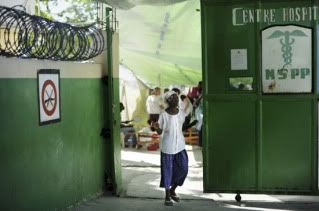(10 am. – promoted by ek hornbeck)
From MSF

Haiti: Treatment Continues Through Powerful Aftershock
On Wednesday morning, as Doctors Without Borders/Médecins Sans Frontières (MSF) teams in Haiti continued to work through long queues of patients waiting for treatment and surgery, the country was shaken anew by a powerful aftershock. In Choscal hospital, where MSF has been running two operating theaters, patients were so alarmed by the tremors that they had to be relocated into tents outside the building. The surgeons stayed in the hospital, however, rotating in regular shifts, performing one operation after another.
In the week since the January 12 earthquake, MSF has established 10 operating theaters in the battered country. Seven are in Port-au-Prince hospitals-Choscal, Trinité, Carrefour and Chancerelle-and three others are outside the capital, in the towns of Leogane and Jacmel. Overall, MSF surgical teams have been carrying out an average of 130 operations per day. Simultaneously, logisticians are racing to find new facilities or rehabilitate damaged ones. Additional operating theaters are being prepared in Leogane and Grand Goave, west of the capitol, and inside Port-au-Prince, where a team expects to complete the construction of an inflatable hospital with two operating theaters by Friday.
Cross posted at The Wild Wild Left
In the meantime, vital medical supplies and equipment are still being diverted to the DR.
Six Doctors Without Borders/Médecins Sans Frontières (MSF) cargo planes loaded with vital medical material like antibiotics have been redirected to Santo Domingo, Dominican Republic. This will delay MSF staff’s ability to treat patients who urgently need it.
These pictures are from Trinite Hospital and were taken by Dr. Paul McMaster, who narrates, and his staff. The hospital was severely damages during the quake and several staff members were killed.

76 comments
Skip to comment form
Author
…. am I missing something here ?
Planes full of medical supplies still being diverted, while even the talking heads on MSNBC say the need for antibiotics is critical or injured people will die of infection?
that asks why? but has no answers…
to thank you for all that you’re doing in Haiti, and for keeping us informed as time permits.
Wishing you all the best: and wishing even more for the devastated Haitian people.
Hopefully the fact that they are now airdropping supplies will alleviate some of the bottleneck problems at the PaP airport.
Can you disclose which hospital facility you are operating from? If you’ve already done this somewhere else, please forgive my missing it.
Again, you’re in my thoughts every day. Take care of yourself during all of this somehow and try to get rest whenever you can.
Here are some orchids for you (from Longwood Gardens):

The story continues to be worsened!
Take good care and TRY to rest!
Blessings!
but I’m going to post it here, as well!
is another initiative:
Urge Congress to Expand Airdrops in Haiti
Wall Street Journal and Haitian misery — I don’t dare say what I’m thinking! But, armed guards in tanks? Gawd help us all! Sick, broken bones, trauma and tanks in our faces!
(Note: Emphasis mine)
great diary at GOS by fishoutofwater: Haiti: Docs Out of Hacksaws, Cruise Ship Sends Deck Chairs topping the A List.
BigSurTree
This is pretty interesting stuff, huh? . . . . . . !
~~~~~~~
seemed to be delaying the supply movements, and the question was raised: “Who is in charge here?” No one had an answer, and then they all agreed–there’s no one person or group in charge. So, every organization, government, and individual apparently is making their own decisions and over-all coordination is still lacking. With this type of haphazard decision-making, people have to be countermanding other people’s decisions, and lord knows how much is lost in the communication process?
Just saw a report about the survivors from a nursing home which is located near the airport. These elderly people were outside on the street, who had gotten no food or water since the earthquake. And they are 20 minutes from the airport.
The reporters also mentioned that individual doctors and other individuals were flying in to the Dominican Republic, driving over to Haiti with supplies and going to Haiti to help out on their own.
A couple of days ago the question of “who’s in charge” was asked of Gen. Honore & he also stated that no one person is clearly in charge. He did say that the US effort is being directed by USAID & he seemed to believe that the military would be better able to coordinate their efforts without the USAID directing things.
I believe you were watching for this decision, in Austin v. Michigan Chamber of Commerce (I could be wrong, if so, please disregard!).
I had mentioned in an e-mail to a friend the other day the following, (plus a great deal more):
Of course, there’s more to that, but I mention it because of the following, which I’ve just read and find, most probably, to be closer to the truth of just about anything we’ve read.
I’ve been harboring these similar thoughts deep down for days now. A deep, sunken feeling inside.
*[Note reference to SOUTHCOM in a comment further up]
getting set up today… video through the linkhole.
Note that the onus of this move has been put on the Haitian government, who we haven’t heard from in some time now, have we?
Well, we’ll see, but doesn’t this all sound a lot like “Katrina” — I mean how many that were displaced from “Katrina” have ever been able to make it back?
We can only hope that there is truly good intent (certainly, a temporary home would be welcome to the Haitians, in lieu of the streets, I’m sure).
n/t Chip